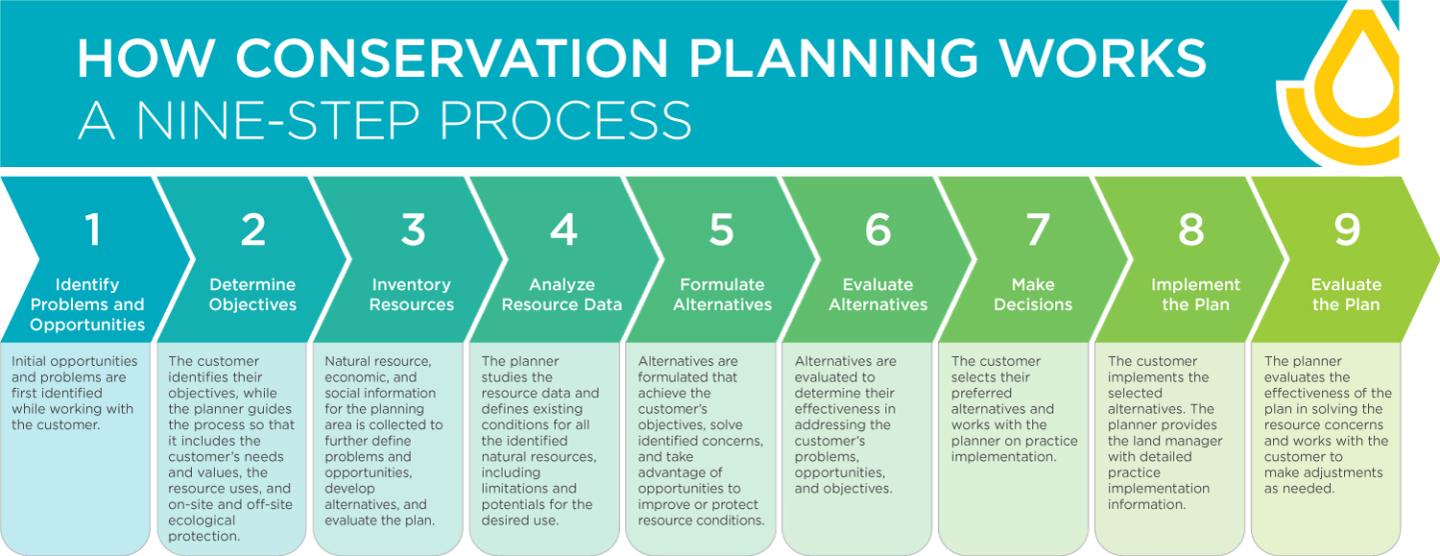The Nine-Step Conservation Planning Process

NRCS uses a nine-step planning process:
1. Identify Problems and Opportunities. Planning can start with a problem, an opportunity, shared concerns, or a perceived threat. Initial opportunities and problems are first identified based on readily available information provided by the customer. There may be information available through local Soil and Water Conservation Districts or through a larger-scale conservation plan.
2. Determine Objectives. During this step, the stakeholders identify their objectives. A conservationist guides the process so that it includes both the stakeholder needs and values, the resource use, and on-site and off-site ecological protection. Objectives may need to be revised and modified as new information is gathered later in the process. Objectives may not be finalized until Step 4 of the planning process
3. Inventory Resources. In this step, appropriate natural resource, economic and social information for the planning area is collected. The information will be used to further define the problems and opportunities. It will also be used throughout the process to define alternatives and to evaluate the plan. It is important that as much information as possible can be collected so that the plan will fit both the needs of the landowner and the natural resources. Inventories can range from a farmstead or small watershed to a complete inventory of resources for a state or the entire nation, such as with the NRCS National Resources Inventory or the Soil Survey Program.
4. Analyze Resource Data. This involves studying the resource data and clearly defining existing conditions for the natural resources, including limitations and potential for the desired use. This step is crucial to developing plans that will work for a landowner and their land. It also provides a clear understanding of the baseline conditions that will help assess how effective a project is after it has been put into place
5. Formulate Alternatives. The purpose here is to achieve the goals for the land, by solving all identified problems, taking advantage of opportunities, and meeting the needs of the planning project. With NRCS conservation planning, we often can help landowners come up with alternatives based on financial assistance programs that help offset the financial expense of implementing conservation practices
6. Evaluate Alternatives. Next is to evaluate the alternatives to determine their effectiveness in addressing the customer’s problems, opportunities and objectives. Attention must be given to those ecological values protected by law or executive order.
7. Make Decisions. At this point, the landowner chooses which project or plan will work best for their situation. The planner prepares the documentation. In the case of an areawide plan, public review and comment are obtained before a decision is reached.
8. Implement the Plan. Technical assistance is provided to help with the installation of adequate and properly designed conservation practices. At this point in NRCS conservation planning, our conservation engineers step in and make designs based on our technical standards. Also, assistance is given in obtaining permits, land rights, surveys, final designs, and inspections for structural practices.
9. Evaluate the Plan. Conservation planning is an ongoing process that continues long after the implementation of a conservation practice. By evaluating the effectiveness of a conservation plan or a practice within a plan, stakeholders can decide whether to continue with other aspects of an overall areawide plan.



